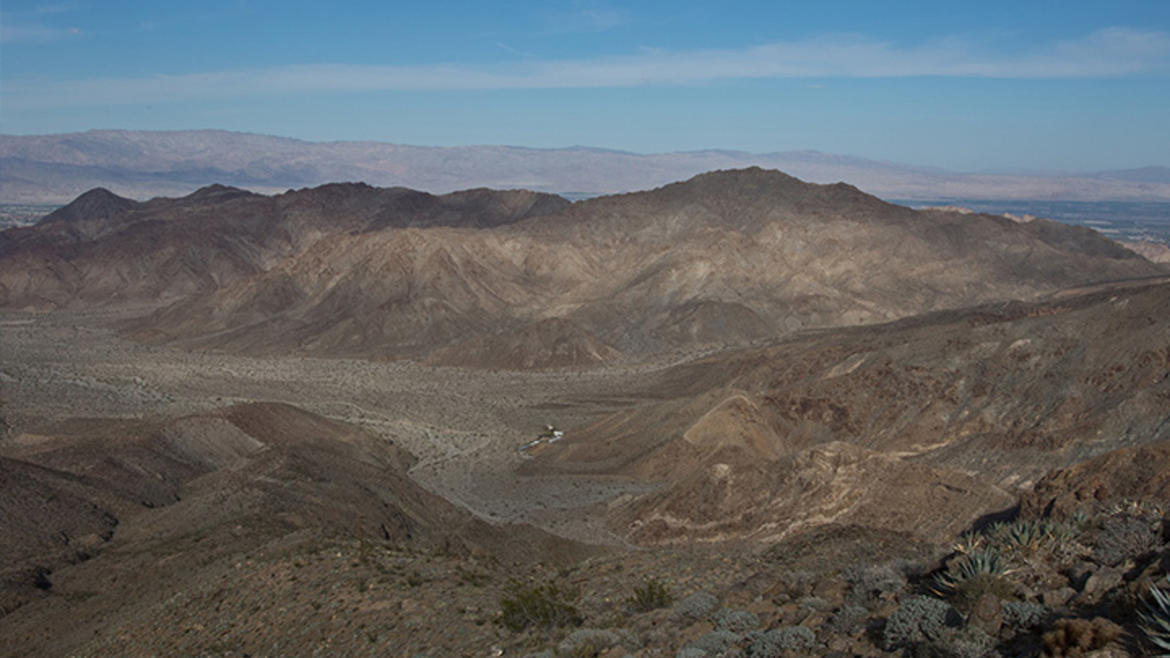
One of the largest NRS reserves, the Boyd Deep Canyon Desert Research Center encompasses a major drainage system descending from the high peaks of the Santa Rosa Mountains down to Colorado Desert. Deep Canyon’s tributaries begin in montane forests, flow across a rolling plateau covered with piñon-juniper woodland and chaparral, join at the head of a precipitous gorge, and plunge 1,180 feet into the canyon. From there, the mouth of the canyon opens out into a broad alluvial fan with sandy washes on the southern edge of the Coachella Valley.
Except for a few permanent pools, the streambed in Deep Canyon’s lower reaches is dry. However, winter storms can trigger dramatic flooding.
The vertebrate fauna is exceptionally rich, with 46 reptile species, 228 birds, and 47 mammals. The reserve is part of the U.N. Mojave and Colorado Desert Biosphere Reserve and it is surrounded by the Santa Rosa and San Jacinto National Monument.
Desert research is also possible at other NRS sites, including Burns Piñon Ridge Reserve, Sweeney Granite Mountains Desert Research Center, and Steele/Burnand Anza-Borrego Desert Research Center.
Exotic Species Removal
A tamarisk and fountain grass management program was initiated in 1996.
Field Courses
Site visits by university courses in ornithology, ecology, botany, plant physiological ecology, biology of ants, conservation biology, cactus and succulents, and others.
Selected Research
- Population biology of the Coachella Valley fringe-toed lizard, a federally threatened species.
- Long-term monitoring of rodent community composition and abundance.
- Nematode ecology and soil carbon flux
- Physiology of succulents.
- Hybridization of quail species.
- Climate change monitoring and analysis
Special Research of National Significance
- Optical Fiber Infrasound Sensor (OFIS)
- Physiological, Demographic, Competitive and Biogeochemical Controls on the Response of California’s Ecosystems to Environmental Change
- Climate change impacts to California ecosystems
Contact Information
Christopher Tracy
Boyd Deep Canyon Desert Research Center
University of California Natural Reserve System
UC Riverside Department of EEOB
54-900 Desert Research Trail
Indian Wells, CA 92210
951-827-3655
christopher.tracy@ucr.edu
Boyd Deep Canyon website
Location
Riverside County, 8 km (5 mi.) south of city of Palm Desert; 2-hour drive from the Riverside campus.
Facilities
Two laboratories w/ basic equipment (balances, etc.), herbarium, small library, housing facilities for 14 researchers, and reserve office at Boyd Center; small four-bunk facility w/ workspace at Agave Hill (no water on site); teaching area and campground for classes. Wireless internet access at Boyd Center and over a broad area of low elevation flood plain.
Reserve bibliography
The reserve bibliography includes citations of journal articles, books, theses, art, and other works published about or based on activities conducted at the reserve.
Databases
Complete herbarium and other synoptic collections; data from six weather stations and ongoing plant/animal monitoring; maps of various scales; reference library w/extensive bibliography of on-site research.
Plant List
Personnel
Resident director, staff biologist, and maintenance person.
Size
2,477 hectares (6,122 acres), and use agreements with the Bureau of Land Management and the USDA Forest Service to access 10,000+ adjacent acres.
Elevation
9 to 2,657 m (30 to 8,716 ft.) within Deep Canyon Transect
Average Precipitation
Annual means range from 15 cm (6 in.) at Boyd Center to 40 cm (16 in.) along the upper plateau
Average Temperatures
January: 10 ºC (51 ºF),
July: 39 ºC (102 ºF)
